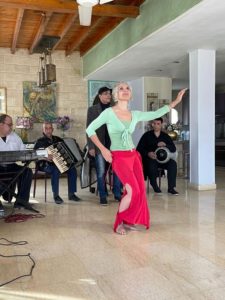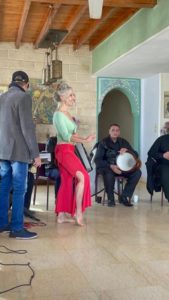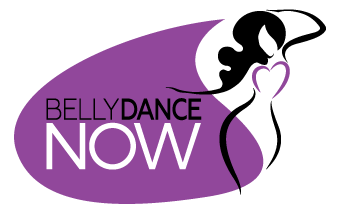Posted on 31/07/2022 by Kay Taylor
Dancing to Live Music by Yasmina of Cairo
I remember very well the first time I danced to music played live by Egyptian musicians. Clutching my cassette tape (yes, it was a long time ago!) I appeared in my costume at the private party I was performing at for an Arab audience in  London, and was told to put it away. It would be insulting, and perhaps even cowardly, they insinuated, not to dance to the live band. ‘Watch the first dancer,’ they suggested, thinking I could pick up some ideas. So I did, feeling very insecure. When they asked her what she would like them to play, she uttered the (to me) intimidating words ‘Oh, anything, I don’t mind!’
London, and was told to put it away. It would be insulting, and perhaps even cowardly, they insinuated, not to dance to the live band. ‘Watch the first dancer,’ they suggested, thinking I could pick up some ideas. So I did, feeling very insecure. When they asked her what she would like them to play, she uttered the (to me) intimidating words ‘Oh, anything, I don’t mind!’
How amazing, I thought, to have such confidence. And she was a foreigner, like me. I don’t remember much about my performance that night (I got through it and no doubt the audience was polite), but as time went on and I began working at a club with a live Egyptian band, the fear faded and my own confidence grew. And then finally, after working for years around the Middle East and Egypt, I discovered that my feeling had reversed: I dreaded performing on stages to a CD, without the energy and security of having musicians behind me.
Of course if you have the luxury of collaborating with the same musicians over time then that is the ultimate way of becoming a blended creative force. But what if this is not the case? You arrive at a show and the musicians are strangers? Or it’s a house band and you are the one that’s unfamiliar to them? It’s important straight away to be clear about what you want, and to remember that they will usually be as keen as you are to present something that shows off your talent and will entertain the audience. Their job is to give life and energy to your performance, just as it is your job to express the beauty of their music with your dance.
Dancing successfully to live music, I think, requires what might seem like two almost opposing things from a dancer: Lots of preparation, and the ability to let go and just go with the flow. These two things are in fact not only compatible, but interdependent. Going with the flow requires you to respond to exactly what you are hearing in the present moment. But you absolutely need the tools with which to do that, which is where technique and hard work are really important.
Preparation
When you know you will be dancing to live music, there is a lot you can do to prepare. Make your Arabic and Egyptian music collection your background  soundtrack and listen to lots of it. Let your ears absorb the melodies and rhythms of each piece until you can sing them in your head, but also take the time to dance in your head: sit or lie down, close your eyes and focus on the music. Do a virtual reality performance, imagining the moves you will make. Then do it again, with a different set of moves or use of your virtual stage. This is important because when the musicians play it it’s unlikely to sound exactly like you’ve heard it on a recording. These days the chances are you will be able to listen to different recordings of the same song, which will also serve to reassure you that the basic melody and structure of the song will be the same on each, even if the instrumentation varies.
soundtrack and listen to lots of it. Let your ears absorb the melodies and rhythms of each piece until you can sing them in your head, but also take the time to dance in your head: sit or lie down, close your eyes and focus on the music. Do a virtual reality performance, imagining the moves you will make. Then do it again, with a different set of moves or use of your virtual stage. This is important because when the musicians play it it’s unlikely to sound exactly like you’ve heard it on a recording. These days the chances are you will be able to listen to different recordings of the same song, which will also serve to reassure you that the basic melody and structure of the song will be the same on each, even if the instrumentation varies.
On the subject of instrumentation, a huge benefit of dancing to live music is that, so long as there are several instruments making up the band, you can choose which ones will lead the melody, enabling you to ‘customize’ a song the way you would like it. So for example if you are dancing to an instrumental version of a classic song, you can ask for the violin to play the vocal track instead of the singer, lending a keenly emotional edge to it. Or the kanoun or oud (one or the other; unless it’s a large orchestra there are unlikely to be both, even in Cairo) to play a more acoustic version of the vocal track, giving it a softer, more pared down feeling.
Leading into the song you could ask for a taksim by one or more of the instruments – something a CD will rarely offer you. And even if it does, it will not have that combination of the feelings of the musician as he plays the taksim in that particular moment, on that particular day, and your response to it as you move. That unique expression of feeling and dual energy created together in real time is something you can only have with live music.
Repetition
Repetition is an important characteristic of Arabic music, and indeed, of Egyptian  dance. Having the confidence to repeat a movement without worrying the audience will be bored by it, or think that your repertoire is too limited, should stop you from making it too busy or frenetic. When a singer feels the audience has really enjoyed a phrase they may well repeat it, and if you are dancing to it they may indicate this to you also. Such a live interaction between the audience and the musicians and dancer gives a wonderful sense of sharing.
dance. Having the confidence to repeat a movement without worrying the audience will be bored by it, or think that your repertoire is too limited, should stop you from making it too busy or frenetic. When a singer feels the audience has really enjoyed a phrase they may well repeat it, and if you are dancing to it they may indicate this to you also. Such a live interaction between the audience and the musicians and dancer gives a wonderful sense of sharing.
Be flexible and know your music
It is always good not to be fixed on a particular song or mis en scene/mejancee. Have some alternatives that you can ask for. Classics are good, as they will be in the repertoire of most professional musicians. Tarab songs by classic composers such as Mohamed Abdel Wahab or Baligh Hamdi (often originally sung by Oum Kulthoum, Abdel Halim Hafez, Warda etc.) will be in their repertoire, and provide some of the richest material for dancers. But take note: most of these songs have several parts to them, including an introductory section or instrumental sections without vocal, and are often really long. So you need to be able to identify which section of the song you want them to play. It might be the intro plus the first verse and chorus. Or it might be the first and second verse with chorus but without the intro. Or it might just be the intro – some of the opening sections of music from tarab songs are long enough to provide a complete dance by themselves. When you listen to a version of a classic Oum Kulthoum song on a belly dance CD there probably won’t be any information about which section of the song it is, or which lyrics refer to which verse. What to do if you have no opportunity for a proper rehearsal? The easy answer is, be prepared to sing the sections you want to the musicians! By the time you have decided on your favourite options this should be possible even if singing is not your strong point. Then you will all be clear about what they are going to play, and there will be no surprises.
As mentioned before, there is no problem if there is no singer; one of the lead instruments can play the vocal melody. Of course a good singer adds an extra emotional element to any band and will give you as the dancer that extra layer to work with also.
What to avoid
Brand new pop or shaabi songs are less likely to be playable by the average live band. Rehearsal time costs money, not to mention effort by the musicians, so  unless the song has already become a standard favourite that is bound to be requested a lot they are unlikely to have rehearsed it. The same goes for a mise en scene/mejancee: don’t expect the average live band – even in Cairo – to know the music from a CD produced in the last 30 years, unless they work with a dancer who regularly uses it. Popular ‘classic’ mejancees such as ‘Set el Hosn’ or ‘Aziza’ are still, amazingly, the ones most likely to be known by Egyptian or Lebanese bands everywhere. They never seem to get old.
unless the song has already become a standard favourite that is bound to be requested a lot they are unlikely to have rehearsed it. The same goes for a mise en scene/mejancee: don’t expect the average live band – even in Cairo – to know the music from a CD produced in the last 30 years, unless they work with a dancer who regularly uses it. Popular ‘classic’ mejancees such as ‘Set el Hosn’ or ‘Aziza’ are still, amazingly, the ones most likely to be known by Egyptian or Lebanese bands everywhere. They never seem to get old.
Modern shaabi songs require a good keyboard that emulates the production sound of ‘maharagan’ songs – most of which are only produced on a keyboard anyway. If the band you are working with doesn’t have one of these it’s not going to sound great. And to sing in shaabi or maharagan style also takes a certain kind of vocalist. On the plus side, if all you have is a keyboard player (which can often happen!) with a rhythm box, then he may well be able to produce a street shaabi sound better than a classical band.
Beginnings and endings
No matter what music you choose and agree to with the band, nothing matters more than your entrance and how you finish. If you are lucky enough to be performing a whole set (in Cairo this can last up to an hour!) you can plan a range of styles, moods and ideas for a complete show. But if you are performing just one piece of music, every minute counts and you have less time to make an impact. This certainly doesn’t mean you should rush onto the stage and try to perform lots of showy technique as fast as possible. But your first appearance is very important and should look professional. This means arranging with the musicians how and at what point you will appear. Often they will play a pre- introduction while you are off stage (many classic mejancees have one of these already in them), announce your name, and then you will come in with a travelling step at the ‘lead in’ point in the music. This gives a strong dynamic feel to your entrance and allows you to make an introductory sweep of the stage, acknowledging the audience. You can then arrange to move continuously into the music, or to do a dramatic spin, stop and ‘begin’.
If there is no obvious pre-intro, the musicians can play the opening bars of the song, then give you a drum break of four or eight counts for you to come in with, and carry on into the song once you are on stage. This is known in Arabic as an ‘arrbaa’ (which just means four). Having them play before you appear obviously builds anticipation for the audience – something which Cairo dancers are notorious for, sometimes letting the band repeat the intro music ten times before they deign to make their entrance!
If you are confident enough to carry yourself onto the stage without music and start on stage, this can also work dramatically. In this case the dramatic tension for the audience comes from not knowing what you are about to do. You can stand in front of them allowing them time to take in your gorgeous costume and overall magnetism, before launching into the first bars of beautiful music. This works for a section of tarab song which starts slowly; an example could be ‘Lissa Fakir’.
If you don’t want the awkwardness of a silent walk-on, and if the lighting is good enough, you can have a blackout and be already standing on stage as the lights come up. This though is more likely to be in a theatre situation where you can pre-arrange it with the lighting technician.
The ending is just as – if not more – important, since it’s the last thing you leave your audience with. There are different ways of ending your performance, and you don’t need a rehearsal to communicate what you want to the band. But you must have the conversation. The two main endings are known as the ‘pirouette’ and the ‘cut’. The ‘pirouette is pretty self explanatory, and just means they draw out the final note and you spin until you stop – and they stop with you. You don’t stop with them. You decide and they will follow. A notorious sign of the dancer’s lack of experience is when she keeps on spinning waiting for them to stop, as they wait for her…you can imagine the result. The ‘cut’ is preferable but sometimes requires a rehearsal, or at least ask them to sing the final phrase before you go on so you are in agreement. Lots of songs have a natural ‘cut’ ending, and it looks neater and more professional.
In Between
During your performance try forget whatever choreography you might have worked on to the song they are playing, and to instead actively listen to what they are playing. This where the letting go comes in. Try, even before you get on stage, to at least make a good connection with the tabla player, so he is on your side. Let him know that you want him to follow your accents when you make them (not the other way round.) To help with this process, don’t be afraid to make eye contact with him during the performance, even if this means turning your back on the audience. You really need to do this to keep him focused on you. There is nothing more annoying than noticing that the drummers are not even looking at you, but you have to be pro-active within this relationship, especially if they haven’t worked with you before.
Your own experience in terms of training; understanding rhythms and how to transition them smoothly; how to decide in the moment whether to go with rhythm or melody, these are stages that come with your experience.
 But no matter what happens on stage, and whether it’s your first or hundredth time dancing to live music, there will be a sense of exhilaration, an energy level you can’t beat, and an immersion into the music, that you will not feel dancing to a recording. And this is the living expression of oriental dance at its best!
But no matter what happens on stage, and whether it’s your first or hundredth time dancing to live music, there will be a sense of exhilaration, an energy level you can’t beat, and an immersion into the music, that you will not feel dancing to a recording. And this is the living expression of oriental dance at its best!
You can put this into practice with Yasmina – and learn more about dancing with live music at Summer School – starts 19th August: It is not too late to book.
Or sign up to Bellydance Music Explored, our online music course which will inform how you dance forever.
Yasmina began her dance career on the Arab and Greek nightclub stages of London during the 1980’s, danced around the Middle East in the 1990’s, and has been based in Cairo since 1995 where she performed nightly for eight years with her orchestra. She runs the Belly Dancers’ B&B in Cairo, hosts dance groups, gives workshops with live music and teaches around the world. She has also produced seven music CD’s in Cairo for dancers available here: yasminaofcairo.bandcamp.com
Yasmina is a founding director of Bellydance Now, and a teacher on the Bellydance Now Music Course
